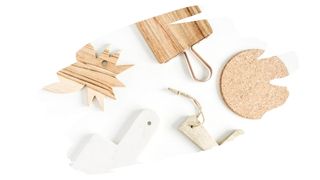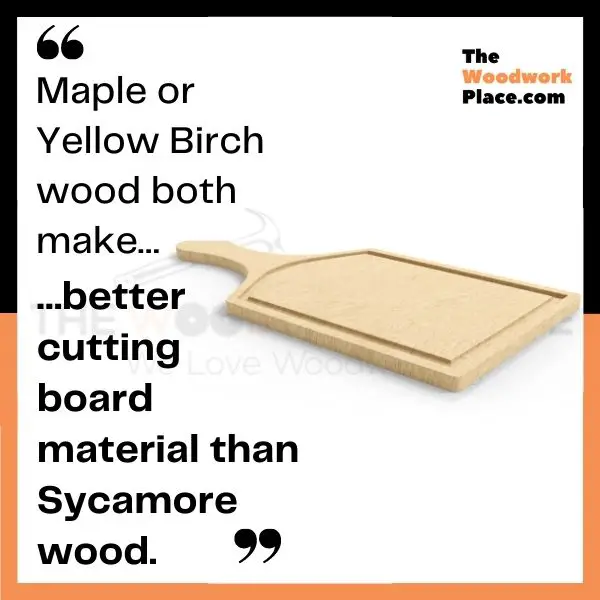A well made cutting board begins with well-selected lumber. The aesthetics of a beautiful edge-grain board won’t mean much if it splinters and frays after you start using it.
Related Post: Edge Grain vs Face Grain Cutting Boards (Which Is Which?)
That’s why, (when it comes to crafting a home made chopping block), choosing the right type of wood really matters. But, could sycamore wood really be the type of timber you’re looking for?
Well, in this post, you will learn what makes natural wood one of the most food-safe cutting board materials. You will also discover what makes Sycamore trees antibacterial—and why it may not count for much when it comes to chopping blocks.
And we reveal why the Janka rating of Sycamore is key to deciding whether to use this wood for your cutting board.

This post may contain affiliate links to products that we receive a commission for (at no additional cost to you). Learn more here.
What Is The Best Material For A Cutting Board?
Any cutting board material needs to meet two key criteria:
- 1). It needs to be antibacterial (or at least easy to sanitize).
Any material that is easy to clean, (without much fuss), is what you are looking for.
- 2). It needs to be a durable material.
Cutting board material needs to be tough enough to take on those sharp blades. Still, more than that, it can’t be so tough that it ends up damaging those self-same kitchen utensils.
So, material such as plastic, rubber, and wood (including bamboo), are all ideal for making cutting boards.
What’s The Healthiest (Most Food Safe) Cutting Board Material?
Modern-day materials, such as plastic and rubber, don’t hold a candle to natural wood. That’s because solid natural lumber has a special antibacterial quality.
You see, wood, plastic and rubber can all be sanitized after use. However, only wood actively works during use to draw bacteria away from that cutting board surface.
This is all because of woods amazing ability to soak up water and liquids like a sponge.
Natural wood absorbs water incredibly quickly, (and more readily), than any plastic or rubber surface. This fast-absorption ability is called ‘hygroscopy’.
Due to woods hygroscopicity, a wooden cutting board actively works towards soaking in raw meat juices and liquids.
Now, bacteria thrive and grow in those liquids. So, by quickly drawing that liquid down and off the surface, those harmful microbes won’t get a chance to multiply.
Why The Type Of Wood Grain Matters Too
Woods antibacterial advantage only works best when paired with tight grained timber. This is because open grained wood can get bits of food caught up in the texture of their wood grain.
And those trapped food bits will provide a perfect environment for dangerous microbes to flourish. So, when it comes to choosing cutting board wood, always stick to tight grained timber.

So, Is Sycamore Wood Antibacterial?
Sycamore is a natural hardwood lumber with fine tight grain. Which makes it as antibacterial as most any other wooden surface.
However, the wood of Sycamore trees isn’t inherently more antibacterial than any other type of lumber. And its lumber does not contain some kind of hidden antiseptic compound.
Instead, the special antibacterial qualities of the Sycamore are actually found in it’s tree leaves.
Antiseptic compounds in the leaves of the American Sycamore tree can be effective in staving off certain types of fish bacteria.
In short; Sycamore tree lumber is just as antibacterial as any other natural wooden surface.
Can You Make A Cutting Board Out Of Sycamore?
Well, antibacterial qualities aside, Sycamore falls short on that other key cutting board criteria; durability.
While you can make a cutting board out of Sycamore, that board won’t last long. That is because this lumber isn’t tough enough to handle life in the school of hard chops.
Wood, Durability And The Janka Scale
One of the main ways we measure woods durability is by working out how much force it takes to make a dent in it.
This measure is called the ‘Janka Hardness Scale’. And this scale measures how many pounds of force it takes to embed a small metal ball into a piece of wood.
The higher the Janka rating, the harder the wood.
For example, something like Maple wood has a Janka rating of 1450. So that means it takes 1450 pounds of force to make a dent in this hardwood.
Related Post: Cherry Vs Maple Cutting Boards (3 Essential Comparisons)
Now, when it comes to making cutting boards, you ideally want wood that has a Janka rating between 900 and 1500. Wood types outside of this narrow Janka range will either be too soft, or too hard, as a chopping block.
Sycamore wood has a Janka rating of just 770, which puts it well below the minimum threshold for optimal cutting board wood.
In other words, a Sycamore cutting board isn’t great for anything more than light food prep. Otherwise, you risk chopping it to bits!

OK Then…What Type Of Wood Is Best For A Cutting Board?
Maple wood is by far the best choice for a cutting board. It’s a straight grained timber, (with a similar grain texture to Sycamore). And it is tough enough, (at 1450 Janka rating), to handle life as a chopping block.
Other than Maple, you could make your cutting board out of Yellow Birch wood as well. The fine almost wavy texture of birch wood is tight enough to keep food bits out.
And with a Janka rating of 1260, Birch wood is hard enough to handle sharp slicing kitchen utensils too.
Related Post: Is Birch Wood Any Good For Cutting Boards?
To Wrap Up, Here Are The 3 Main Takeaways…
- 1). Sycamore tree leaves contain an antiseptic compound. Still, the actual lumber of this tree is no more antibacterial than any other hardwood.
- 2). Cutting board wood should have an optimal Janka rating between 900 lbf and 1500 lbf. Sycamores Janka rating is too low, at just 770 lbf.
- 3). Maple or Yellow Birch wood both make for better cutting board material than Sycamore wood.



